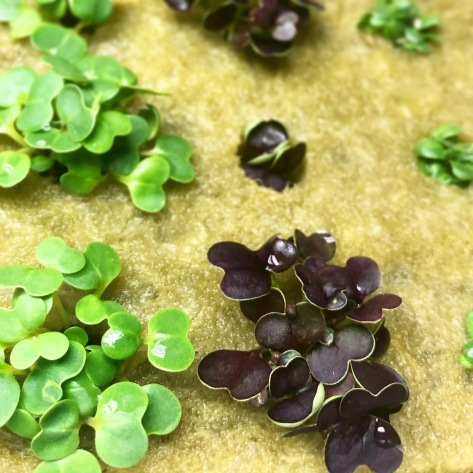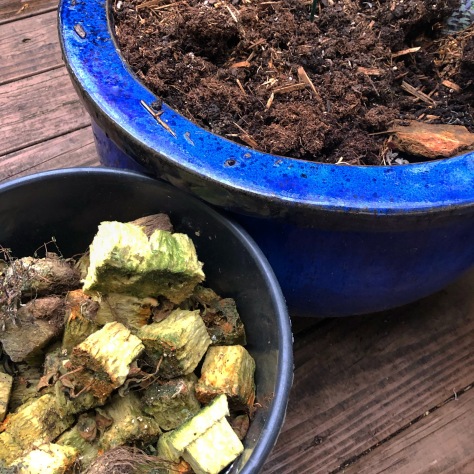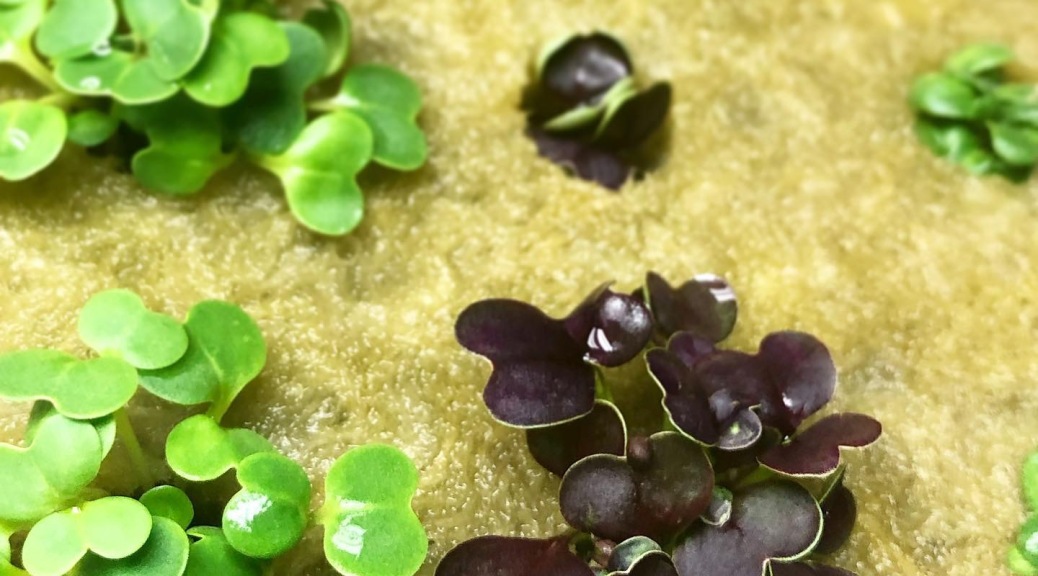For those who grow fruits, vegetables, and herbs in hydroponic systems (like the Tower Garden by JuicePlus+ ), growing in rock wool (also known as stone wool) as a substrate growing medium provides structure for a plant’s root zone while also retaining moisture to help the plant’s roots uptake the nutrient’s the grower is providing.
But what is rock wool anyway?
Rock wool is essentially basalt lava rock and chalk, heated to high temperatures and then spun like cotton candy into fine fibers and then pressed together into cube forms or whatever form is desired for it’s use. Rockwool is commonly used in hydroponics because it is pH neutral and the air-pockets formed in it’s creation, makes it ideal for retaining oxygen and moisture — two main things plants need in their root zone. It also has enough strength to support the plant’s root structure making it a great resource for starting seeds. [Pictured below: 2″ x 2″ cubes as a 98 cube sheet await a new planting.]

Using Rock Wool to Start Seeds
Seed starting works well in rock wool — so well that it is not only hydroponic gardeners that use rockwool. Some soil-based gardeners start seed in rock wool and then transplant seedlings into their soil-based planters and garden!
A couple of things to keep in mind when using rock wool
How to utilize water and air with your seedling:
Water must be available to your seed to start the quickening of respiration that leads to germination — it needs to penetrate the outer seed casing. However, few seeds will germinate if they are “drowning” in water; some air must reach the seed for the seed to germinate. The oxygen taken in by the seed through respiration combines chemically with the seed’s fats and sugars and is referred to as oxidation. That being said, you want to pre-soak your rock wool and then let excess water drain off. You should never let your rock wool sit in water and remain water logged.
Here’s my process for preparing rock wool with water for seed starting:
- Grab a large bowl (large enough to submerge a piece of conjoined dry rock wool as I prefer to leave my rock wool attached at this stage) and fill it with filtered water. (Helpful Tip: If you don’t have a water filter to dechlorinate your water, you can find options here.)
- I like to add a small capful of micronutrients found in liquid kelp or fish fertilizer. If you don’t have this on hand, don’t worry, good ol’ filtered pure water will work just as well. You’ll want to lower your pH to around 5.5-6.0. (Helpful Tip: You can check your pH using a pH Meter like this one here.)
- Submerge your dry rock wool cubes (still joined together — don’t break them apart) into your bowl and prepared water. Allow it to sit for about 10 minutes to soak up water. The water will move into all those air pockets within the rock wool.
- Lift the block of rock wool cubes (you’ll notice when you go to pick up the block of rock wool cubes it is noticeably heavier now that it has soaked up water) and place into a clean plastic tray.
Tip: place seeds on a new clean wetted paper towel and give the seeds a sealed cover of some source to aid in germination. When the root emerges from the seed casing, immediately gently move with a tweezer the germinated seed into a rock wool cube at a depth the width of the seed casing. Flood the germinated seed placed in wetted rockwool with light at this point.
5. Add dry seeds to each rock wool or if using the moist paper towel method, transfer already germinated seeds using a clean sanitized tweezer and gently placing the germinated seed into a rock wool cube at the depth noted on your seed packet (or about the same depth as the width of the seed. Note: some seeds need to start in total darkness, some need light, some it doesn’t matter. You’ll want to check this resource here for recommendations on whether or not to cover your seed with vermiculite or not.
Quick note to Tower Garden Growers at this point: Vermiculite is often provided along with your Tower Garden purchase as part of the seed package. It comes in a little clear envelope. Some people say you don’t have to use it, but they don’t understand that some seeds need darkness and some need light, so be sure to refer to the handy chart I’ve provided for knowing when to cover your seeds with vermiculite and when to skip covering it at all. In case you’re wondering, Vermiculite is made from compressed dry flakes of a silicate material which is absorptive and spongy making it a great option for covering seeds keeping balance of moisture and oxygen that a seed needs. BTW, thank you Tower Garden for providing this in each order!!!
How to utilize temperature and light with rock wool in your seed starting:
Remember the story of Goldilocks? She tried the porridge that was too hot, too cold, but settled on the one that was just right? That’s what plants are like when starting out as seedlings… the seed needs just the right temperature. Some types of plants prefer cooler temps and some plants prefer it warmer. Peppers, eggplant, melon seeds, and such prefer warmer conditions and lettuce, celery, and peas, tend to germinate best at lower temperatures. Some seeds like tobaccos, dock, and evening primrose like alternating temperatures of warm and cold to germinate.
Helpful Tip: Here’s a handy reference if you’re not sure what your seeds should start out at temperature wise.
Typically (and I put an asterisk here to refer back to my previous helpful tip) most plants like to germinate around 70ºF-75ºF. Keep in mind this is SOIL temperature, so if you have a plant sitting in soil or rock wool, it is going to be cooler than the ambient air temperature. You’ll need to warm up the wetted rock wool to the plant’s desired temp of around 70ºF-75ºF (or otherwise if the seed requires a cooler or warmer temp).
Here’s my continued process for preparing rock wool for seed starting:
6. Okay, you’ve done steps 1-5 above and are now ready to continue… Place your wetted rock wool with seeds sitting in a plastic tray and place onto a warming pad. (Don’t forget to label what you planted!)
7. Set your warming pad to 70ºF-75ºF and place your wetted rock wool + seeds = both sitting in plastic tray onto the warming pad. Then, put a bright light with red/blue light mix over your seed tray (if not starting outdoors or in a greenhouse.)
Helpful Tip: Seedlings need bright light to grow well and if using artificial light, make sure your light source is about 7-10″ above your rock wool. As plants grow towards the light, raise your light source to maintain this distance. Don’t forget that plants need a resting period without light just like we need sleep. Limit your lighting to 12 hours a day at most and let your baby seedlings rest at night, this will build up sugars in the plant for growth the next day.
8. Daily monitor the “wetness” of your rock wool. Like mentioned earlier, you don’t want your rock wool to be sitting in and inch of water. The top of your rock wool should be moist to the touch, but not very “wet”. Make sure you water your seedlings from the top of the rock wool and pour any extra “run off” from what the rock wool didn’t retain into your sink or Tower Garden reservoir.

How to utilize airflow in your seed starting:
There’s one last thing to think about when starting seeds in rock wool. You need proper airflow. If your rock wool is too wet and there’s not air flow, you’re going to grow bacteria that’s within the air or that somehow gets on the surface of your growing medium and you’re going to grow mold, not plants. So give your baby seedlings air movement with a fan in the room (doesn’t need to be directly on them), but just keep air moving and your seedlings will thank you for it.
You may get some green stuff on the top of your rock wool — this is called algae and it grows when there is moisture and light. If you have a swimming pool or use a lake in the South, you know what this stuff is already! It can steal nutrients from plants if not kept in check. If you’re seeing algae, don’t sweat it. Your plant will be fine. You can always cover the top area of your rock wool with strips of white plastic (old white plastic blinds work well for this) between seed rows if you want to inhibit algae growth as light feeds it through photosynthesis. I find that a little bit on top of my rock wool doesn’t affect my plant’s growth in a hydroponic Tower Garden system and just try to make sure I’m not keeping the growing medium too wet.
Helpful tip: If you are growing larger plants, like tomatoes, in a hydroponic bato bucket system you will want to cover as much of the growing medium as possible. I’ve found planting parsley at the same time I put my tomato seedlings in will help keep algae growth down. The Tomato grows faster than the parsley and as the parsley fills in, I can harvest it as needed. In the meantime, the parsley will block out light keeping algae growth on the surface to a minimum. Win!
When your seedlings are about an inch or two tall, they are ready to be transplanted into your growing system like a Tower Garden.
What to do with your rock wool when your plant is done growing in it:
I live in the Southeast United States, near Atlanta, Georgia and we get this nickname “Hotlanta” for a good reason — it gets blazing hot in the summer! After a plant has gone through it’s entire growth cycle and it’s time to pull the plant and clean my system for a new crop, I toss all my rock wool (roots and all) into a dry bucket and let the rock wool dry out completely in the sun. (This will clear out and kill anything that might be bacteria related if there is something that I can’t see.) I then place the used dried out rock wool (dried roots included because those are organic matter and will be good for my soil) and put into the lower third of my potted plants mixed with soil. When I go to water my plants, these pockets of rock wool will retain moisture and help provide water to herbs and flowers planted in these pots on hot summer days. I love that I can re-use this growing medium for another purpose! Win-win!

Where can I find Rock Wool to purchase?
Around January to early February of each year, I like to take a quick inventory of how much rock wool I have on hand for the planting season ahead.

I like this rock wool sold by Tower Garden, because of the larger planting holes. You can easily drop in a pre-germinated seed into the hole, or place a dry seed into the hold and cover with some vermiculite. (See my note above on step #5 about how to use vermiculite.) It also retains water well. The price shown on the Web site includes cost of shipping and Tower Garden ships quick (I usually get mine within a couple of days of ordering here in Atlanta, GA.)
There are two options when ordering this rock wool:
- 98 two-inch cubes as a sheet if you have only 1-2 Tower Gardens
- or do a bulk order of 30 sheets of 98 two-inch cubes per sheet (recommended if you are growing 3 or more Tower Gardens year round or at least spring through fall.)
The rockwool sold by Tower Garden is horticultural-grade rock wool and used by professional growers all over the world. Remember, price listed includes shipping and it ships fast! 🙂
You can also find rock wool on Amazon, but be sure you do the price per sheet calculations and factor in shipping costs. Just make sure you end up with horticultural-grade rock wool and not something that was intended for insulation pressed into a mold for hydroponic use.
Helpful Tip: If purchasing rock wool on Amazon or online, watch the quantity offered as not all sheets contain 98. Some suppliers break the 98 sheet into smaller sheets and charge more. This can be convenient if you only need a few on a moment’s notice and don’t mind paying more per cube, but don’t stock up this way. Buy bulk and in full sheets of rock wool for optimal savings.
Hope that helps! Show us your baby seedlings you start in rock wool by tagging us on Instagram at #gyhg 🙂
Happy Growing!
— Erin
